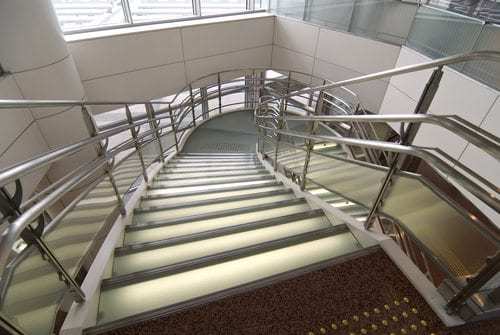AHD Blog
Handrails vs. Guardrails
Handrails vs. guardrails – there is no difference. Right? Not according to their definitions. Most people do not pay much attention to the handrails and guardrails that line stairs. However, ignoring railings completely is never a good idea for your home or business. Just ask your building’s inspector. A complete railing system that is reliable and maintenance free is an investment worth making for yourself and your guests. But how do you know which railing is best for your situation? In this post we will look at the key differences between handrails and guardrails.
Handrails vs. Guardrails
Most people do not rely them, but railings are helpful when you are injured, tired, or wearing heels. They also help young people and the elderly when they need some extra support. In such cases, it can be difficult to navigate stairs or elevated landings without the assistance of a railing. The one question you may have as a home- or business-owner is: when are handrails vs. guardrails required? Knowing the difference between these two types of railings can help you make the call. Remember, the final authority on where and when handrails are required, whether on steps, stairs, landings, balconies, or decks, rests with your local building code official.
Handrails
According to building code, handrails run on the incline up and down a set of stairs. They are intended for a person to grasp with their hand and are used for guidance and support as people climb up and down the stairs.
One of the most common mistakes people make when they install handrails is that they forget to make them graspable. Your fingers should be able to wrap around the railing and grip it tightly in case you take a fall. All handrails for a home or business should be at least one and a half inches away from the wall for optimum grasp-ability.
Guardrails
According to building code, guardrails run horizontally along an elevated landing or other flat area with a drop on at least one side. These types of railings help prevent accidents where a person might fall from a higher level to a lower level. Essentially, guard railings keep you safe so you will not trip or slip off the side of a landing and fall from a considerable height. Guardrails can be installed on elevated walkways and around stair landings for additional safety.
If a guard railing is too low, it fails to provide adequate protection. The minimum height for railings in commercial or public buildings is at least 42 inches above the stairs. Inside residences, the minimum is about 36 inches high.
A Complete Railing System Has Both
Sometimes a handrail will form part of a guardrail, which can confuse people who don’t understand the differing functions of handrails and guardrails. Ultimately, a handrail only needs to be secure enough to provide stability and a continuous guide along a stair or platform, whereas a guardrail must be strong enough to resist breaking if a person falls or pushes on it.
However, both handrails and guardrails are key to preventing falls and protecting people from accidents and serious injuries. Your railing needs will differ from project to project. Let the pros at Aluminum Handrail Direct help you make the best decision for your home or business.
At Aluminum Handrail Direct, we are committed to providing high-quality aluminum handrails that are durable, maintenance free, affordable, and attractive. If you have questions about handrails vs. guardrails or if you are searching for an aluminum railing system that fits your needs, call us at 417-409-3179 or visit Aluminum Handrail Direct’s online store today. We offer handrails, wall mounts, mounting screws and anchors, touch-up spray paint, and much more. We look forward to hearing from you!

